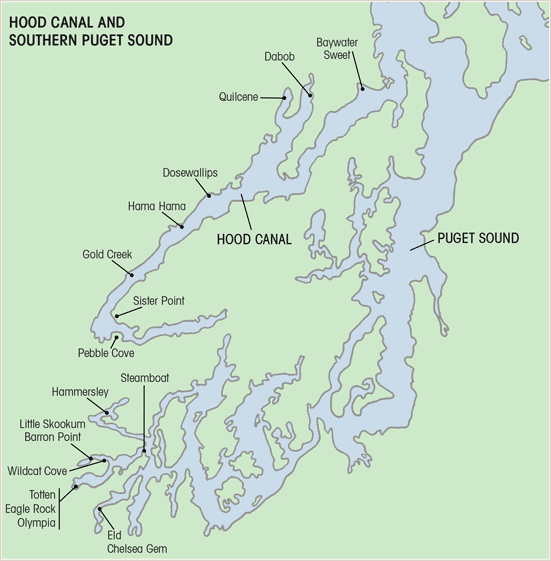Hood Canal and Southern Puget Sound
Puget Sound reaches into Washington State like an arm dipping into a barrel. Its upper arm abuts Seattle, its elbow bends at Tacoma, and at Olympia it spreads five fingers into the land. Those five long, narrow inlets—Hammersley, Little Skookum, Totten, Eld, and Budd—comprise some of the most famous oyster appellations in the Northwest. Budd reaches directly into downtown Olympia and is closed to shellfishing, but the other four are thick with amazingly fast-growing oysters and clams. Each inlet has its distinctions, but they all contribute that characteristic South Sound flavor—full, rich, intense, more sweet than salty, a hint of cooked greens or seaweed, bordering on musky. It’s like a sea version of collards with pork fat.
An extraordinary two hundred miles from the open sea, the South Sound has relatively low salinity; the sea is less of a factor. After navigating all that coastline, the water that reaches the South Sound has experienced countless land influences. It’s also nutrient-rich, thus algae-rich. Rivers, tidal zones, and mudflats each add their own algae-mineral cocktail to the mix. Salmon push up those inlets in fall, flooding them with nutrients when they die. If Eastern oysters smell like wet rocks at low tide, South Sound oysters smell like wet earth at low tide. It’s an acquired taste. But those who acquire it consider milder oysters too boring. They toast each other’s arch taste with a musky Pinot Gris and never look back.
Just a few miles of fir forest separate Hood Canal from Puget Sound, but geologically they are worlds apart. South Puget Sound is a land of gentle terrain and shallow inlets. Hood Canal, on the other hand, is steep and deep: steep mountains above, deep waters below. It’s a genuine glacier-carved fjord, the only one in the continental United States. Oysters adore Hood Canal. The water is kept brackish, cold, and oxygenated by the Olympic rivers. Even more important, the glacier left behind a gravelly till, quite unlike the muddy substrate that dominates Puget Sound. Firm river deltas line the canal, every one of them laced with brackish sloughs and thick with oysters. The classic Hood Canal flavor is very different from that of southern Puget Sound; more lettuce and lemon zest, saltier, less sweet, and very firm for a Pacific.

